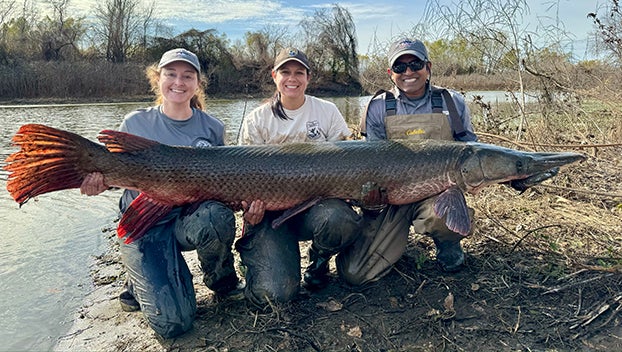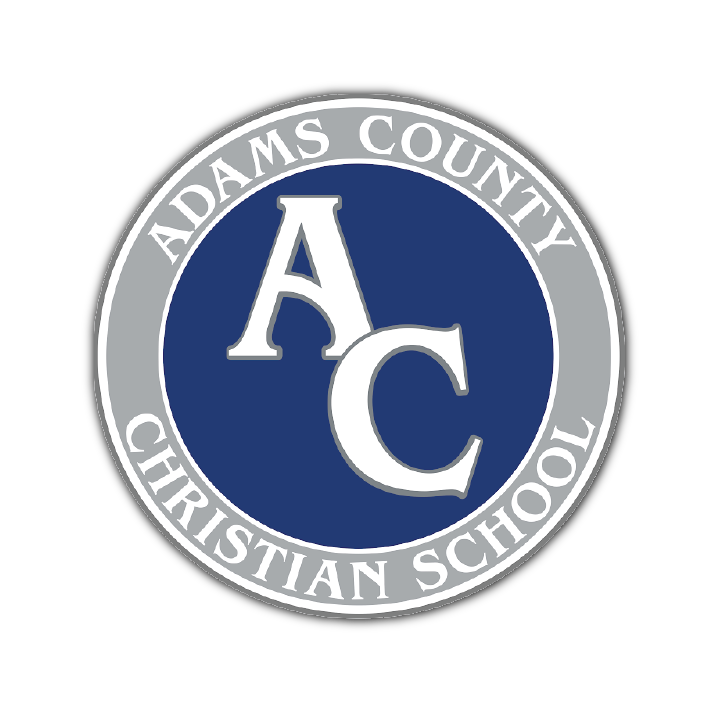Gar for good: Local fish key to research
Published 1:10 pm Wednesday, December 27, 2023

- Members of the research team hold a large Alligator Gar at Saint Catherine Creek National Wildlife Refuge. Nicholls State University graduate student Kati Wright (Left), USFWS Fisheries Biologist Kayla Kimmel (Center), and University of Minnesota Assistant Professor Solomon David (Right). (Courtesy Photo | United States Fish and Wildlife Service)
|
Getting your Trinity Audio player ready...
|
SIBLEY — A healthy gar population calls St. Catherine Creek National Wildlife Refuge home and represents the area’s connection with the Mississippi River. Researchers are studying the gar’s ecology to better understand how to restore gar populations in other parts of the United States.
United States Fish and Wildlife Service Fisheries Biologist Kayla Kimmel said the research work being done on alligator gar at St. Catherine Creek NWR started about 20 years ago and she has been involved with it for 16 years. Aquatic Ecologist & Assistant Professor Solomon David at the University of Minnesota, and founder of the Gar Lab at Nicholls State University, first came to the refuge to work with the population of alligator gar in 2021.
Natchez is a city built on its connection to the Mississippi River. David said the alligator gar should be special to Natchezians because of their shared connection with the mighty Mississippi River. In Minneapolis-St. Paul, the Mississippi River flows close to the University of Minnesota’s campus connecting David to St. Catherine Creek and other gar habitats down the river.
“The gar represents the connection. If they are healthy then you often have a healthy river,” David said. “Gar can be an umbrella species, representing other organisms including water birds, mammals, and plants.. You live in the environment too, and gar can help represent overall ecosystem health. If they are doing well you can feel good about that ecosystem. You don’t see an alligator gar population like that in many places. It makes St. Catherine Creek so much more special. The Mississippi River connects us from north to south, whether you’re in Minnesota or Mississippi.
David and the Gar Lab at the University of Minnesota and Nicholls State come to St. Catherine Creek National Wildlife Refuge to learn more about the life history of alligator gar. Additionally, his students are collecting data to better understand the local food web, including what the gar are eating and where. David said the food web data is developed from taking fin clips and using isotope analysis. The team documents the size of the gar to see how diets might change with body size, and how St. Catherine Creek’s gar compare to other populations of alligator gar in Texas, Louisiana, and Florida.
USFWS is using the information gathered by these students to help understand the genetic makeup of the fish and also form an abundance estimate, Kimmel said. In the spring, scientists return to collect eggs to raise broods of fish in hatcheries. Students provide the manpower needed to complete the study while gaining valuable experience afield.
“It is nice to have the extra hands there. When we are bringing large gar into a tiny boat and pulling up to five or seven gar it can get crazy. We have to process them quickly. There is a lot to do for everyone to come out safely,” Kimmel said. “The gill nets we use are designed for alligator gar and have certain sized holes or mesh for the gar. They are about five inches wide, and really only for gar. We use the boat to set up the gill net with a float on one end and it stretches across the water and sits there like a volleyball net.”
David referred to Kimmel as the gill net expert and that she leads the field operations of the study. Once gar are captured and removed from the net, they are brought back to shore by boat. Biological data such as length, weight and fin clips are taken, and then each gar is implanted with an individual tag (like those used to ID pets), The gar are then released safely back into the refuge water.
Special group of gar
Kimmel said the population of alligator gar at St. Catherine Creek is special because of the health, size and quantity of gar they catch. The area’s connection to the Mississippi River is thought to be one reason why the gar population does so well. St. Catherine Creek is connected to the Mississippi River and floods easily. Alligator gar use the floodplain to spawn and as the flood water recedes they return to the Mississippi River or floodplain lakes on the refuge.
“It is so rare in the river and throughout the floodplain to have those connections and lakes. They hold water where the gar can stay in it all winter. It’s one of the reasons it is so unique,” Kimmel said. “Other areas have modeled the connectivity of rivers to flood plains after St. Catherine Creek. It is a blueprint for restoring other areas to be just as good and productive for gar and other species dependent on that aquatic connectivity.”
Gar are apex predators and help maintain balance in the ecosystem. When prey fish get out of control it could lead to stunted growth and disease in those populations. Gars mostly eat fish like shad, but can eat panfish or bream. They tend to eat whatever is most abundant.
Similar to Natchez and the surrounding Miss-Lou, alligator gar at St. Catherine Creek have a historic connection to the Mississippi River. Kimmel said before the refuge was established the river would still flood the farmland there because the Army Corps of Engineers never built a levee there leaving the connection open.
“Gar connect the river to land, they’ve had a relationship with the flood pulse that has gone on for millions of years,” David said. “They are the top of the food chain, and can show us how the ecosystem might be changing. While alligator gar populations have decreased through much of the species’ range, here, they are still persistent. They are survivors. In this refuge they are doing alright.”
Due to the resilience of alligator gar at St. Catherine Creek, the fish are used to restore other low populations of alligator gar. Kimmel said the fish at St. Catherine Creek are important to the restoration efforts.
One way researchers know St. Catherine Creek’s Gar population is healthy is because of the size of the fish. David said the longest alligator gar they caught in four trips to the refuge was 7.5 feet long. The shortest was three feet long. The heaviest caught out of 58 gar was 164 pounds and the lightest was 40 pounds. An average length and weight was 79 inches and 103 pounds.
“We see the number and size data. If it wasn’t suitable for them they would take off. We can go back year after year and find beastly alligator gars,” David said. “The habitat is still suitable for them.”
Prior research done at St. Catherine Creek National Wildlife Refuge shows the limiting factor for alligator gar in the Lower Mississippi River Valley is spawning habitat availability and accessibility issues due to levees. USFWS has produced maps showing the connection between the Mississippi River, indicating that spawning habitat is limited.
St. Catherine Creek’s gar population is well protected by refuge regulations. No alligator gar can be caught and kept at the refuge.
David said coming to St. Catherine Creek and working there is a great opportunity. He considers himself lucky to be there no matter how many times he has held alligator gar in his hands. Even his enthusiasm may be eclipsed by the reaction of his students and volunteers.
“They might have heard of gars and seen them but to experience it in person is just priceless. I don’t know how else to say it,” David said. “I have worked with them and I am always excited.”
Kimmel agreed. She said they stop catching fish not because they run out of alligator gar but they run out of steam from handling the massive fish.
“I see them all the time but it is such a unique place. The size of fish we catch too. It is priceless and mind boggling,” Kimmel said. “It is so impressive at the same time when you bring in one that large from that area. It is so neat. The students see that and the volunteers too. I tell them ahead of time I know it is early in the morning and cold but it will be worth the wait.”
Check back for a follow up story in Friday’s print edition looking ahead to the future of alligator gar research.






